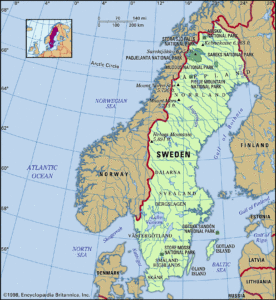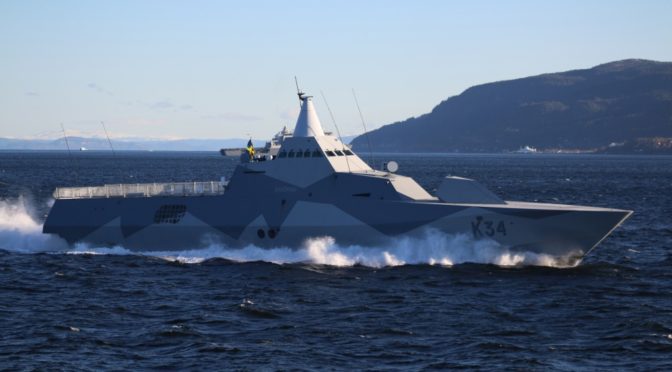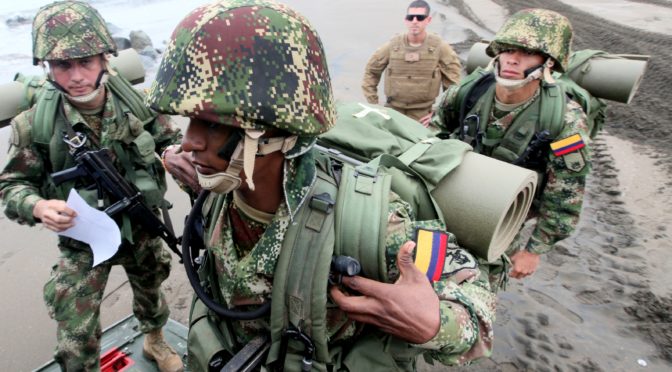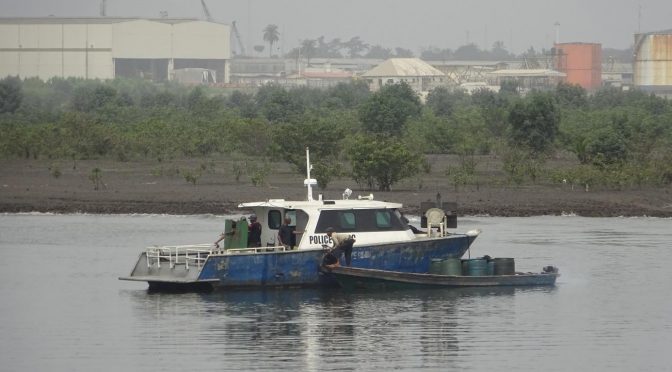Regional Strategies Topic Week
By Lars Wedin
The Royal Swedish Academy of War Science is presently undertaking a study of strategic and operational requirements for the Swedish Armed Forces in the 2030 timeframe. Its naval section has recently published its findings in a book, Vår marin för ett tryggt Sverige och ett starkt Europa. Marin strategi 2030 (Our Navy for a Secure Sweden and a Strong Europe. Naval Strategy 2030).1 This article discusses some of our findings.
Classic naval strategists – Mahan, Corbett, and Castex – basically saw naval strategy as consisting of three major alternative offensive strategies: attack on land from the sea, blockade, and commerce raiding, as well as the corresponding defensive strategies. Sea control (command of the sea is an older term) and its opposite, sea denial are key. French Admiral Raoul Castex summed it up nicely: “Depending on whether one has command of the sea or not, one may or may not:
- be in an offensive mode, intercept the communications at sea of the enemy and attack his territory from the sea;
- be in a defensive mode, guarantee one’s own communications and prevent the enemy from attacking one’s territory from the sea.”2
Today, the spectrum of maritime warfare is much broader and fluid. Some parts of this spectrum, such as nuclear deterrence, are only relevant to the navies of larger powers, but many are highly relevant also to coastal navies.
Geographically, Sweden is a maritime country dependent on sea lines of communications (SLOCs) for its international trade but also, increasingly, for domestic transportation. Its biggest port is Gothenburg, but there are important ports along all its 2,700 kilometers of coastline. The sea around Sweden is divided into three operational areas by the straits of Öresund and the Åland archipelago. Strategically, Sweden borders the Arctic in the north, Russia in the east, the EU in the south and the Atlantic Ocean in the west. The country is not a member of NATO but enjoys a close partnership with the alliance. It is a member of the EU, and has close military relationships with other Nordic countries, especially Finland. The Swedish navy is modern and capable, but much too small for the tasks expected of it.

The Blue Society
The future of humankind lies at sea, which is demonstrated by the 70-80-90-99 rule: the sea covers 70 percent of the surface of the globe, 80 percent of its population lives near the sea, 90 percent of goods are transported on ships, and 99 percent of world’s digital information is carried by submarine cables.3 Two thirds of the world’s wealth is also produced at, or in, the sea. One could talk about a littorialization of the world’s population and thus of its economy.4 In sum these trends form what one could call a blue society – a society turned toward and dependent on the sea, its possibilities, and challenges.
Several important factors drive this development. It is well-known that the globe’s major reserves of oil and gas lie beneath the sea; there are tens of thousands of platforms of different kinds and more than 100,000 people serve on them. Climate change drives the construction of an ever-increasing number of wind farms and other forms of at-sea power generation. Climate change also drives moving traffic of goods from roads to ships (and railways). Mineral resources at sea are increasingly important as well as resources for the biochemical and pharmacological industry. Fishing – catch of wild fish as well as fish farms – is of vital importance for a large part of the world’s population. Shipping and related activities are vital for the economy. Just in the EU, some 574,000 people work in ports, a sector worth a collective €89 billion.5, 6
To conclude, the old adage of Corbett that “Command of the sea, therefore, means nothing but the control of maritime communications, whether for commercial or military purposes” is no longer sufficient. The sea itself is now intrinsically important. He is still correct, however, when he stated that naval warfare is not about “the conquest of territory.”7
Littoralization in Scandinavia
Two extreme cases of littoralization are the interlinked mega-regions known as Western Scandinavia and Greater Copenhagen. The former includes southwestern Sweden and southern Norway while the latter covers the Danish and Swedish parts of the Öresund. 30 percent of Norway’s and 33 percent of Sweden’s populations live in Western Scandinavia which is responsible for the major part of Norway’s and half of Sweden’s GDP.8 A driving factor is the area’s largest ports, Gothenburg and Helsingborg, which link the region with the global market. Greater Copenhagen is, from an economic point of view, an integrated area on each side of one of the world’s most busy waterways, where around five million people live.
Even minor disturbances may create great economic danger to the countries in the region. Hybrid warfare could be a very effective mode of attack due to the dependence on vital infrastructure. For instance, just a suspicion of mines in the waterways would cause disruption; such a suspicion is relatively easy to spread through a disinformation campaign. Their actual use would cause great harm. Due to the archipelago covering the port of Gothenburg, preventive mine-hunting would require significant resources.
The defense of such a littoral area with its thousands of islands, broad countryside, as well as modern cities, as well as extensive transport networks would be very complex. One might add the great sensitiveness of modern ports as well as infrastructure in general to attacks in cyberspace.
Infrastructure – Changing the Geography of the Littoral
Trends in building new infrastructure on the sea – the construction of wind farms and diverse platforms for oil and gas including the deployment of Floating Liquefied Natural Gas (FLNG) and Floating (production) Storage and Offload (F(P)SO) – change the operational seascape.9 These facilities are a sort of hybrid infrastructure, where they retain the permanence of land-based facilities but are located out at sea. In the Swedish context, only wind farms are relevant.
Windfarms may cover large areas and they produce noise that may conceal the presence of submarines. It is believed that a wind turbine has a radar cross section of around 10,000 meters squared. The movements of the blades affect a doppler radar, which is in current use in modern aircraft. Wind farms, covering large areas, constitute a new tactical environment. Submarines, especially midget submarines, and fast attack craft (FAC) may conceal themselves in such areas and would be very difficult to detect. In fact, during the Iran-Iraq war in the 1980s, Iran used its oil platforms as bases for their fast attack craft – the famous Boghammar.10 Sweden also has a goal of 100 percent renewable energy by 2040. Wind farms at sea are bound to play an important part in this program.11 Consequently, such wind farms become strategically important and, hence, a target for warfare.
Another aspect of infrastructure is constituted of cables. Cables may be damaged accidentally or intentionally, but their information could also be intercepted by specialized submarines. It is believed that the Russians are very capable in this area. Stopping information through cable-cutting is a measure already used since the Spanish–American War of 1898. Electrical power is also transmitted through cables on the seabed. The strategically important Swedish island of Gotland is highly dependent on electricity from the mainland. Sweden is also connected to the EU internal energy market through a network of such cables.13, 14
A final type of growing infrastructure is the bridges that connect Sweden, Denmark, and Germany. They are of clear strategic importance but vulnerable. They also constitute physical obstacles – modern aircraft carriers may not enter the Baltic Sea because the bridges are too low. The Great Belt and the Öresund have, historically, had great strategic importance. They still have as they link, or separate, the Baltic Sea from the Atlantic area.
In sum, infrastructure at sea is strategically important, but vulnerable. A complete command of the sea would constitute an efficient defense but such a command is likely impossible. Consequently, this is an area in need of tactical development.
Technology – A Force Multiplier
Naval officers tend to equate military capacity with the number of keels or missile tubes available. These metrics are important of course, but technology creates new possibilities. A primary observation is that distances, expressed as range, depend on technology: “The physical arena is as big as before when considered in linear dimensions, in kilometers. However, when expressed in passage time, it is much reduced.”15 Until now, range has been dependent on a ship’s organic sensors and weapons. Now, the use of drones changes this.
Drones will have an increasing role to play in surveillance, as decoys, and as weapon platforms over, on, and under the surface. Drones for undersea, surface and air use will be networked together. The future naval force will probably have a number of such drones for communications, targeting purposes, and as weapon delivery platforms. With the development of standard interfaces, drones will be able to communicate among themselves. This also means that one ship may use another’s drone. Artificial Intelligence (AI) will make it possible for drones to cooperate actively and independently to a great extent.
For the Swedish Navy, there are a number of possible tactical uses. A critical one is the surveillance of the undersea domain in ports and important parts of archipelagos in search of mines and minisubs. Another is increasing the sensor range for ships on surveillance missions. Sweden could perceive cargo ships loaded with military units that “suddenly” steer toward Swedish ports as an important threat.16 AI will help in detecting such moves early on.
Swedish corvettes will (finally) be equipped with medium-range anti-air missiles. This will give these ships quite a new role as part of the Swedish air defense, which has mainly depended on the Air Force. Sweden has bought the Patriot system, but the number of systems and missiles is not known and probably small. The contribution of the Navy, with its staying power at sea, could be significant. New ships may be constructed with built-in sensors in the hull, in engines, and weapon systems. This may make planned maintenance less important as the sensors will be able to report continuously on the condition of the material. The aspect of cybersecurity will, obviously, be very important in this context. These are just some examples of what new technology may have to offer a small navy.
Naval Diplomacy
Aircraft carriers are sometimes called “100,000 tons of diplomacy.” But even smaller navies and ships can be applied toward naval diplomacy. The general objective is to shape the strategic environment to one’s advantage, to reassure friends, and earn the respect of potential enemies. Naval presence is the basic action in the context of naval diplomacy; without presence, there is no diplomatic effect. Naval diplomacy and presence can cover a range of actions that are not clearly defined from one another, and may be engaged in simultaneously. Naval presence may produce a number of strategic effects (interdiction, coercion, creation of friendship and confidence) depending on the actions of the deployed naval force. But the result also depends on posture and credibility. This can be illustrated by the following formula: Diplomatic result = (action plus posture) times credibility. Naval diplomacy and presence can cover a range of actions that are not clearly defined from one another. Naval diplomacy also influences one’s own perceptions of others, and can help mitigate the assumptions that come with mirror imaging.
Even a small navy like the Swedish Navy can engage in a range of naval diplomatic activities. To be present at sea with capable naval ships with well-trained crews is a priority in peacetime. It is also necessary in order to keep track of developments in the busy seas surrounding Sweden. Exercises with friends (the U.S., NATO, Finland, and others) create the necessary interoperability and mutual trust needed in crisis and war. It also has a deterring effect showing that they are able to fight together even though Sweden is not a formal member of NATO. Naval visits are a classic and effective way of creating mutual friendships.
More controversial would be efforts to approach the Russian Navy. Russian presence in the Baltic and adjacent seas is a fact and perfectly legal according to the UNCLOS.18 All states in the area share an interest in the keeping of good order and safety at sea. The problem with Russia is, of course, its rather aggressive posture and its actions against Ukraine. However, simple exercises at sea could be a way of creating some degree of mutual trust. As the sea is free, such endeavors would be less controversial than activities on land.
Conclusion
A small navy like the Swedish Navy does not seek to be able to project power on a global scale – not even on a regional one. It cannot protect SLOCs in contested areas far away. But it can, and must, promote and defend its interests at sea in its own area of interest. It can also be a small but important player in larger contexts as shown, for instance, by the Swedish participation in Operation Atalanta off the coast of Somalia.19
In fact, even small navies will see enlarged requirements as a result of the increased importance of the sea in the context of the blue society – a society dependent on the sea and its use. This will include traditional missions like defense of territory against amphibious operations and protection of shipping. But it will also include new missions in the context of the increased importance of infrastructure at sea. Technology will create new possibilities also relevant for small navies, such as through drones, AI, and new missiles.
Representatives of major navies often tend to see smaller navies – without the whole panoply of naval might – as less relevant. But a small navy may be as relevant as a large one in the context of its own strategic environment, and where larger allies may depend on their success.
Lars Wedin is a retired Captain R Sw N. He is the editor of Tidskrift i Sjöväsendet which, since 1835, is the journal of the Royal Society of Naval Sciences founded in 1771. He is also a member of the Royal Academy of War Sciences.
References
- Odd Werin, Lars Wedin: Vår marin för ett tryggt Sverige och ett starkt Europa. Marin strategi 2030, Kungl. Krigsvetenskapsakademien, Stockholm, 2020.
- Raoul Castex: Théories stratégiques, Institut de Stratégie Comparée et Economica, Paris 1997, vol V, p. 87.
- Slightly adapted from Remarks by the Honorable Ray Mabus Secretary of the Navy 27th Annual Emerging Issues Forum: Investing in Generation Z Raleigh, NC Tuesday, 7 February 2012. https://www.navy.mil/navydata/people/secnav/Mabus/Speech/emergingissuesfinal.pdf
- République Française : Stratégie nationale de sûreté des espaces maritimes, Paris, 2015. p. 5.
- Before Brexit and the Coronavirus Pandemic
- The EU blue economy report 2019, Publications Office of the European Union, Luxembourg 2019.
- Julian S Corbett: Some Principles of Maritime Strategy, Conway Maritime Press, London 1972 [1911], p. 90
- OECD: OECD Territorial Reviews: The Megaregion of Western Scandinavia, OECD Publishing, Paris 2018, https://read.oecd-ilibrary.org/urban-rural-and-regional-development/oecd-territorial-reviews-the-megaregion-of-western-scandinavia_9789264290679-en#page15. www.greatercph.com/about
- See Lars Wedin: Maritime Strategies for the 21st Century. The Contribution of Admiral Castex, Paris, Nuvis, 2016, p. 164 – 165.
- http://www.navalhistory.org/2013/04/18/operation-praying-mantis-18-april-1988. Accessed March 10, 2014.
- https://www.regeringen.se/debattartiklar/2017/12/vi-vill-gynna-vindkraften-till-havs/
- See https://www.submarinecablemap.com/
- Lars Wedin: “L’île De Gotland. Clé De La Mer Baltique”, Stratégique 2019/1-2 (N° 121-122), p. 103-115.
- Hållbar och säker elförsörjning, Svenska kraftnät, 2020, https://www.svk.se/sakerhet-och-hallbarhet/hallbarhet/hallbar-och-saker-elforsorjning.
- Castex: Théories stratégiques, vol III, p. 153.
- The realism of this perception is open to some doubt but it is regarded as a fact in Swedish defense policy circles.
- Martin Motte: “Splendor Rei Navalis”, Stratégique, no. 118, 2018, p. 81
- UN Convention on the Law of the Sea
- See Robert McCabe, Deborah Sanders and Ian Speller (eds): Europe, Small Navies and Maritime Security. Balancing Traditional Roles and Emergent Threats in the 21st Century, Routledge, 2019.
Featured Image: TRONDHEIM FJORD, Norway (Oct. 30, 2018) The Swedish navy corvette HSwMS Nyköping (K34) transits Trondheim Fjord in Norway, Oct. 30, 2018, as part of NATO exercise Trident Juncture 2018. (U.S. Navy photo by Lt. Cmdr. Pedro Miguel Ribeiro Pinhei/Released)










